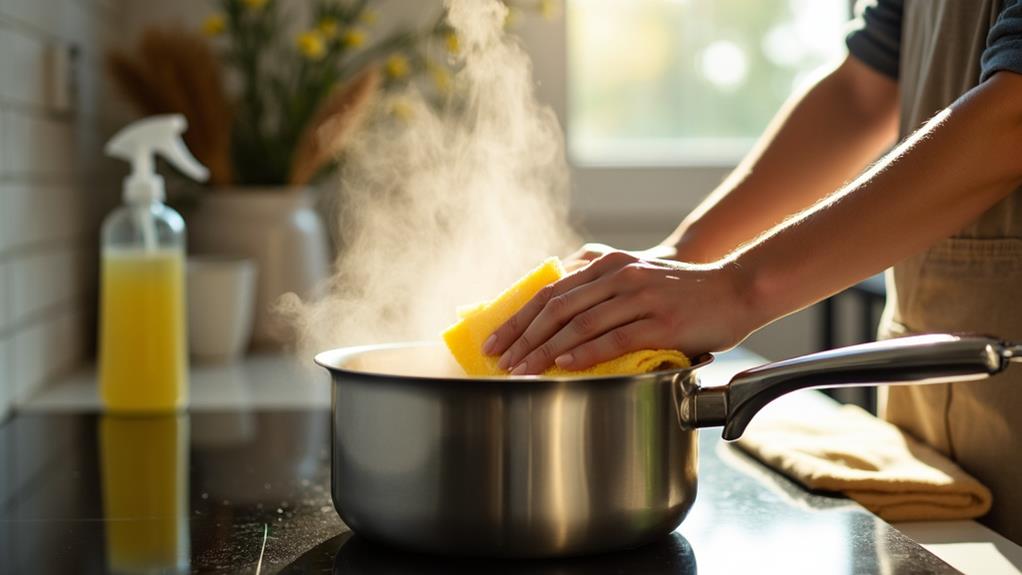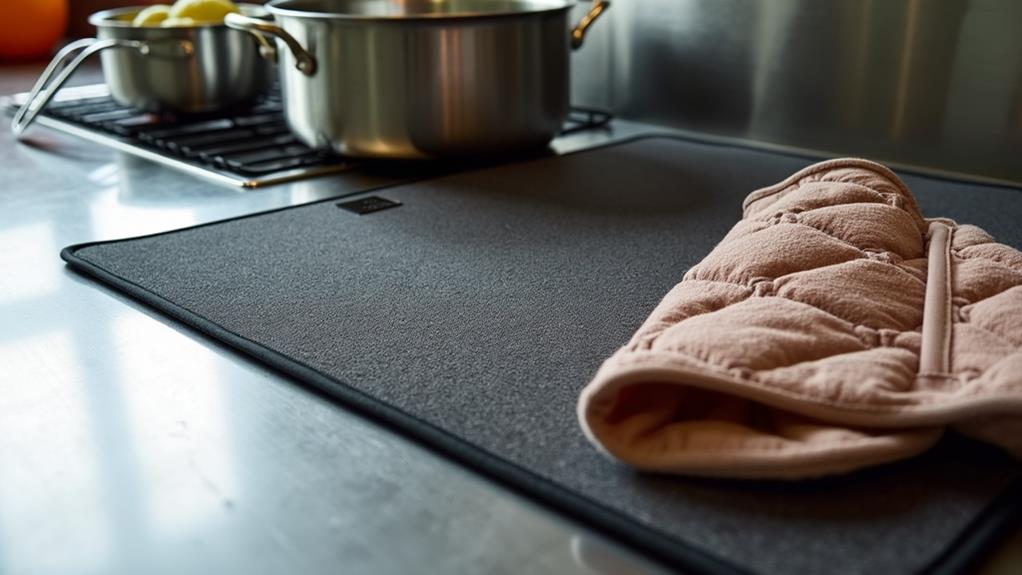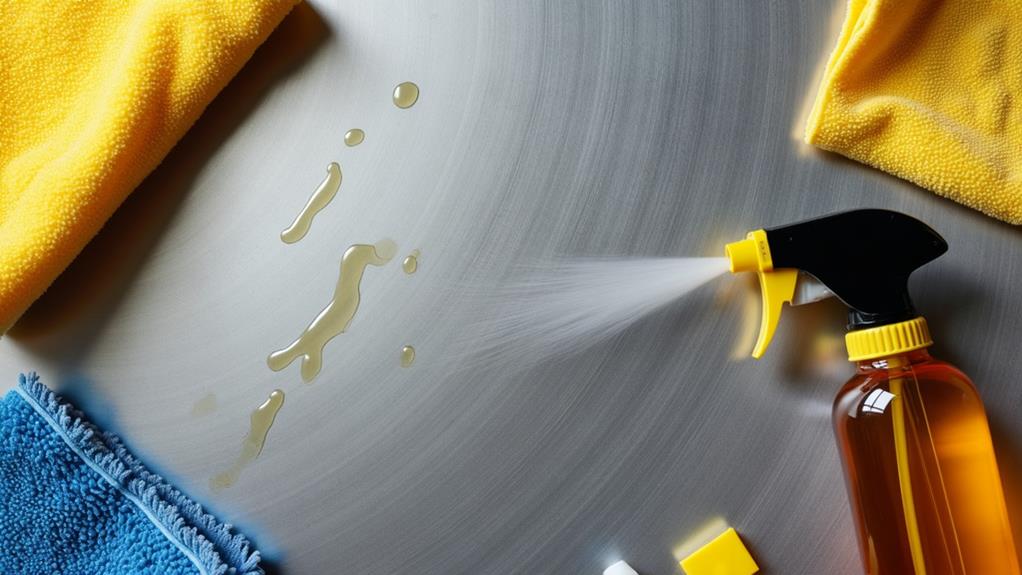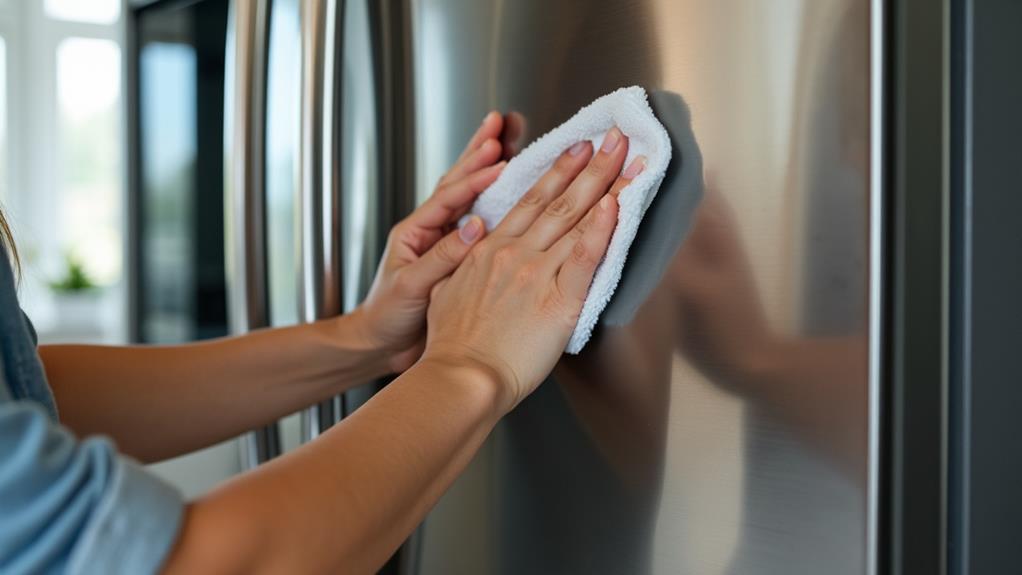How to Remove Water Spots From Stainless Steel Sinks
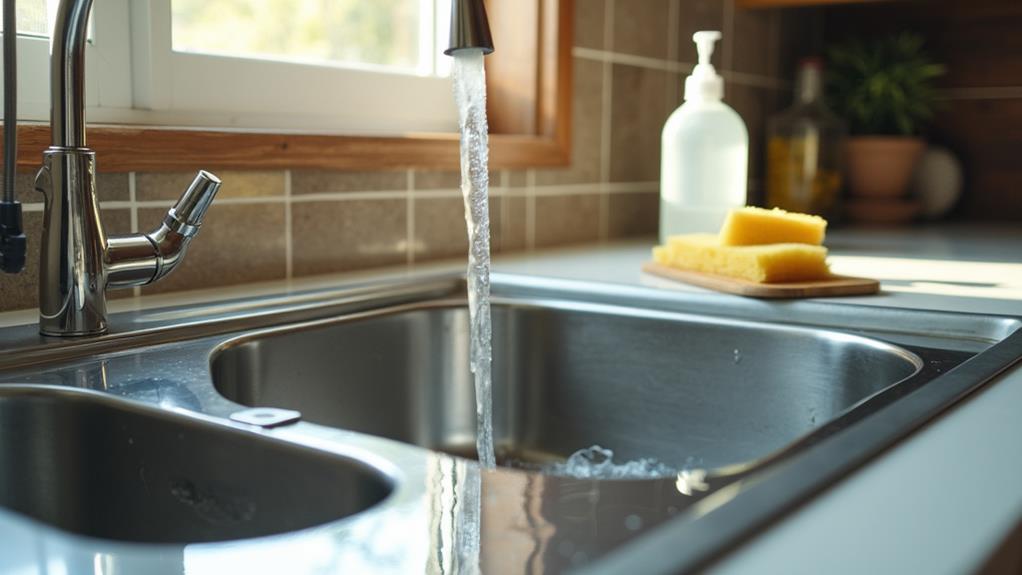
To remove water spots from your stainless steel sink, start by spraying a mixture of equal parts white vinegar and water on the spots. Let it sit for five minutes, then wipe with a soft cloth following the steel's grain. For tougher spots, apply a baking soda paste, scrub gently in circular motions, rinse, and dry thoroughly. You can also use lemon juice or buff the sink with olive oil for added shine and protection. Regularly drying your sink after each use helps prevent future spots. Continue, and you'll uncover even more effective methods and maintenance tips.
Understand Water Spots
Understanding water spots is vital before you can effectively remove them from your stainless steel sink. Water spots form due to minerals left behind when water evaporates. These minerals, primarily calcium and magnesium, are more prevalent in hard water. When droplets dry, they leave a residue that can appear as cloudy or white spots on your sink.
Water chemistry plays a significant role in the formation of these spots. Hard water contains higher concentrations of dissolved minerals, making spots more pronounced. You'll notice that regions with hard water often struggle more with these stubborn spots. Identifying if you have hard or soft water can help you understand the severity and frequency of water spots.
Surface tension also affects how water behaves on your sink. Water tends to bead up because of surface tension, leading to concentrated spots when it evaporates. Stainless steel surfaces, while durable, have microscopic grooves where minerals can settle, making them appear more visible.
Gather Necessary Supplies
Before you tackle those pesky water spots, you'll need to gather the required supplies. The right cleaning tools and materials will set you up for success and guarantee your stainless steel sink shines like new. Start by grabbing a pair of rubber gloves to protect your hands from any harsh cleaning agents. You'll also need a soft microfiber cloth or sponge, which is gentle enough to avoid scratching the surface but tough enough to remove stubborn spots.
Next, get some white vinegar, a natural cleaner known for its effectiveness in breaking down mineral deposits. A spray bottle will come in handy for even application. Don't forget to have baking soda on hand, as it works wonders in combination with vinegar, creating a fizzing action that lifts away grime.
For those hard-to-reach areas, an old toothbrush or a small scrub brush will be invaluable. Ultimately, keep a dry, clean towel nearby to buff the sink after cleaning. These supplies are crucial for employing effective techniques that will make your sink sparkle. Once you have everything ready, you're all set to move on to the next step.
Use Vinegar Solution
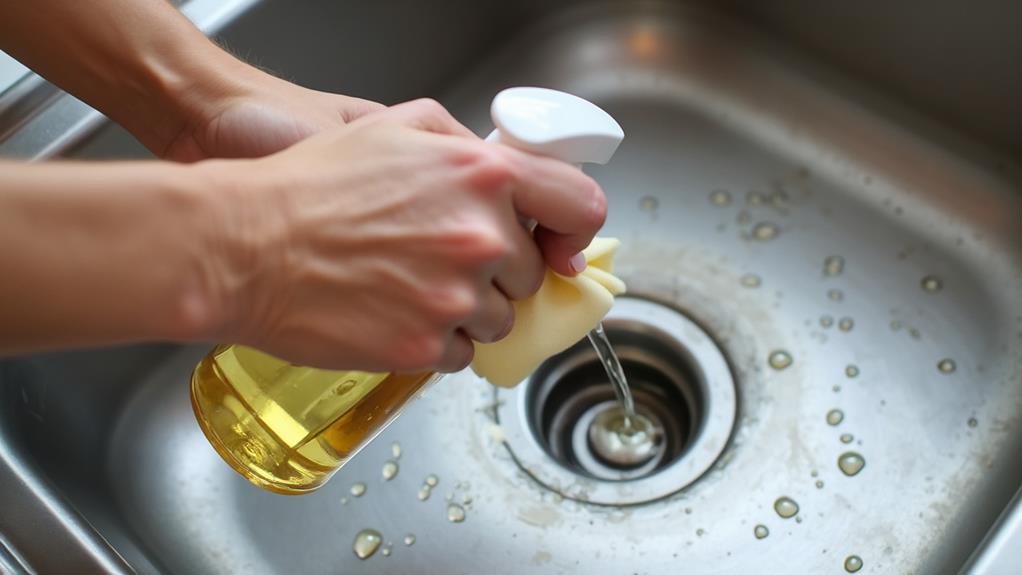
With your supplies in hand, it's time to tackle those water spots head-on using a vinegar solution. Initially, fill a spray bottle with equal parts white vinegar and water. The vinegar benefits are numerous—it's a natural disinfectant, and its acidity helps dissolve mineral deposits, making it ideal for removing water spots.
Spray the vinegar solution generously over the affected areas of your stainless steel sink. Allow it to sit for about five minutes. This gives the vinegar time to break down the mineral deposits causing the water spots. After the waiting period, wipe the sink with a soft cloth or sponge, moving in the direction of the grain to avoid scratching the surface.
If you're not a fan of the smell of vinegar, consider vinegar alternatives like diluted lemon juice, which also has natural acidity and cleaning properties. However, vinegar is generally more effective and readily available. For tougher spots, you might need to reapply the solution and give it another few minutes to work its magic.
After you've cleaned the sink, rinse it thoroughly with water and dry it with a microfiber cloth to prevent new water spots from forming. Your stainless steel sink should look shiny and spotless!
Baking Soda Paste Method
For stubborn water spots that resist vinegar, the baking soda paste method offers an effective solution. Start by mixing a tablespoon of baking soda with just enough water to form a thick paste. This paste is mildly abrasive, allowing you to scrub without damaging your stainless steel sink.
Apply the baking soda paste directly onto the water spots using a soft cloth or sponge. Work in small, circular motions, ensuring you cover all affected areas. The gentle abrasiveness of the baking soda will help lift the mineral deposits that cause those unsightly spots. As you scrub, you'll notice the spots begin to fade.
Once you've thoroughly scrubbed the area, rinse the sink with warm water. Make sure all the baking soda residue is washed away. Dry the sink with a clean, soft towel to prevent new water spots from forming.
This method is one of the most effective cleaning techniques for tackling persistent water spots. Plus, baking soda is a natural, non-toxic cleaner, making it safe for you and the environment. Give it a try the next time you struggle with stubborn water spots in your stainless steel sink!
Try Lemon Juice
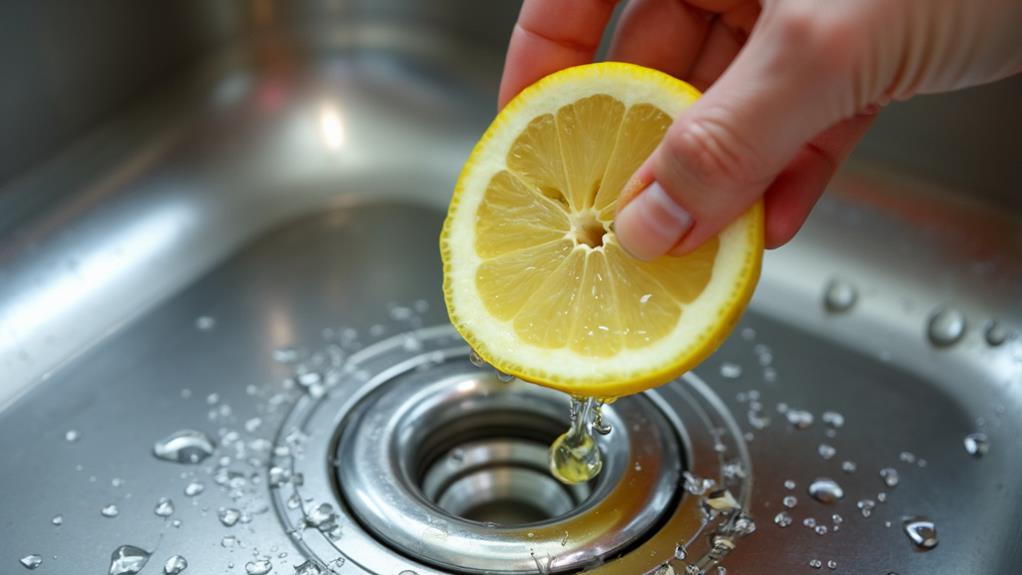
If the baking soda paste method hasn't completely eliminated the water spots, give lemon juice a try for a fresh and natural alternative. Lemons are not only great for cooking but also serve as a powerful natural cleaner. The acidity in lemon juice helps dissolve mineral deposits, making it easier to wipe away those stubborn water spots from your stainless steel sink.
To start, cut a lemon in half and squeeze the juice directly onto the affected areas. Let the lemon juice sit for a few minutes to allow its natural acids to break down the mineral deposits. The lemon benefits are twofold: it cleans effectively and leaves a pleasant, citrusy scent behind.
Next, use a soft cloth or sponge to rub the lemon juice in circular motions over the water spots. Make sure you cover all the affected areas. After scrubbing, rinse the sink thoroughly with warm water to remove any lemon residue. Ultimately, dry the sink with a clean towel to prevent new water spots from forming.
This simple, eco-friendly method not only removes water spots but also adds a sparkling shine to your sink, making it look brand new.
Apply Olive Oil
To give your stainless steel sink a lasting, streak-free shine, try applying olive oil. It's not just for cooking; olive oil offers surprising benefits regarding household cleaning. Start by ensuring your sink is clean and dry. Then, take a soft cloth and pour a small amount of olive oil onto it.
Gently buff the surface of the sink with the cloth, using circular motions to spread the oil evenly. The olive oil will not only improve the stainless steel shine but also create a protective layer that helps repel water spots and fingerprints.
Here are some key olive oil benefits for your stainless steel sink:
- Natural and Non-Toxic: Olive oil is safe to use around food preparation areas.
- Adds Shine: It brings out the natural luster of stainless steel without harsh chemicals.
- Protective Layer: Helps prevent future water spots and fingerprints.
- Cost-Effective: A little goes a long way, making it an economical choice.
Once you've applied the oil, let it sit for a few minutes before buffing it off with a clean, dry cloth. You'll notice a remarkable improvement in the appearance and cleanliness of your sink.
Prevent Future Spots
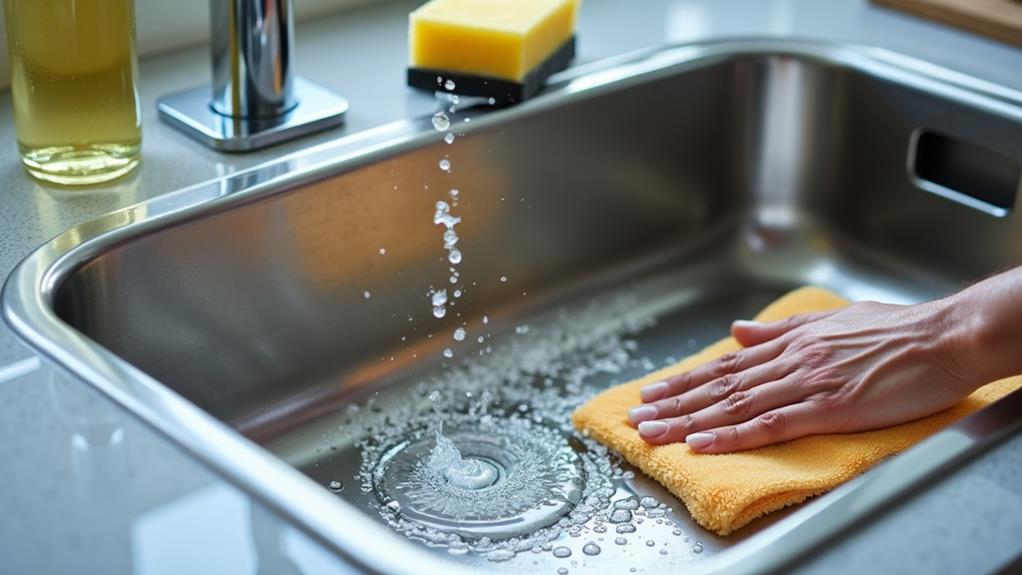
After enhancing your sink's shine with olive oil, the next step is to prevent future water spots from forming. One of the most effective spot prevention methods is to guarantee your sink stays dry. Water spots form when minerals in the water are left behind as it evaporates. So, make it a habit to wipe down your sink after each use. Use a soft, dry cloth for effective drying.
You can also reduce water spots by using a water softener. Softened water has fewer minerals, which means fewer residues that can create spots. If installing a water softener isn't feasible, try using distilled water for rinsing your sink occasionally.
Another tip for spot prevention is to avoid leaving wet items in the sink. Sponges, dishcloths, and utensils can trap water underneath, leading to spots and potential rusting. Take a moment to dry these items and store them away from the sink area.
Lastly, consider applying a protective coating to your sink. Products specifically designed for stainless steel can add a layer of protection, repelling water and making it harder for spots to form. By following these steps, you'll maintain a spotless, gleaming sink.
Maintain Regular Cleaning
Maintaining regular cleaning is key to keeping your stainless steel sink looking pristine. By sticking to a consistent cleaning frequency, you'll prevent buildup and keep water spots at bay. You don't need to spend hours scrubbing; just a few minutes each day can make a huge difference.
First, gather your cleaning tools. A mild dish soap, a soft sponge, and a microfiber cloth should be your go-to items. Avoid using abrasive materials like steel wool, as they can scratch the surface.
Here are some tips to help you maintain regular cleaning:
- Daily Wipe Down: After using the sink, quickly wipe it down with a soapy sponge and rinse with warm water.
- Weekly Deep Clean: Once a week, give your sink a thorough clean. Use baking soda and water to create a gentle abrasive paste for scrubbing.
- Dry Immediately: After each use, dry your sink with a microfiber cloth to prevent water spots from forming.
- Monthly Check-Up: Inspect your sink monthly for any signs of stains or rust and address them promptly.

